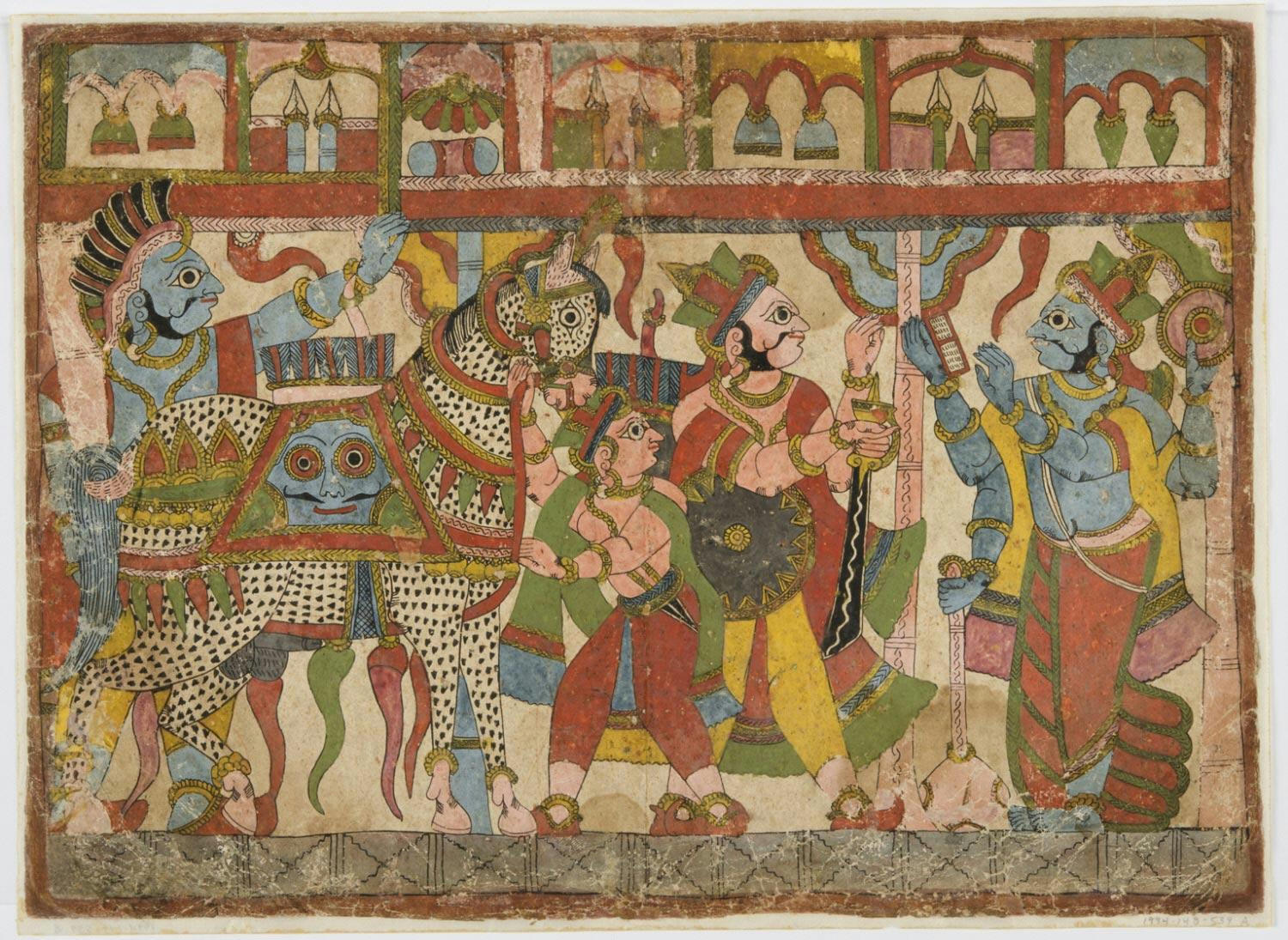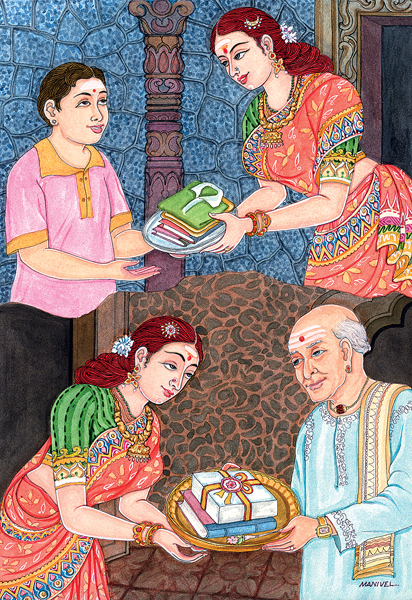|
Jaimini Sutras
Jaimini was an ancient Indian scholar who founded the Mīmāṃsā school of Hindu philosophy. He is the son of Parāśara and is considered to be a disciple of sage Vyasa. Traditionally attributed to be the author of the '' Mimamsa Sutras''James Lochtefeld (2002), The Illustrated Encyclopedia of Hinduism, Vol. 1 & 2, Rosen Publishing, , pages 438, 437-438, 746 and the '' Jaimini Sutras'', he is estimated to have lived around 4th to 2nd century BCE. Some scholars place him between 250 BCE and 50 CE. His school is considered non-theistic,FX Clooney (1997), What’s a god? The quest for the right understanding of devatā in Brāhmaṅical ritual theory (Mīmāṃsā), International Journal of Hindu Studies, August 1997, Volume 1, Issue 2, pages 337-385 but emphasizes ritual parts of the ''Vedas'' as essential to ''dharma''.P. Bilimoria (2001), Hindu doubts about God: Towards Mimamsa Deconstruction, in Philosophy of Religion: Indian Philosophy (Editor: Roy Perrett), Volume 4, Routl ... [...More Info...] [...Related Items...] OR: [Wikipedia] [Google] [Baidu] |
Brahma Sutras
The ''Brahma Sūtras'' (), also known as the Vedanta Sūtra (Sanskrit: वेदान्त सूत्र), Shariraka Sūtra, and Bhikshu-sūtra, are a Sanskrit text which criticizes the metaphysical dualism of the influential Samkhya philosophy, and instead synthesizes and harmonizes divergent Upanishadic ideas and practices about the essence of existence, postulating Brahman as the only origin and essence of everything. It is attributed to the sages Bādarāyaṇa, who is also called Vyāsa (arranger), but probably an accumulation of incremental additions and changes by various authors to an earlier work, completed in its surviving form in approx. 400–450 CE. The oldest version may be composed between 500 BCE and 200 BCE, with 200 BCE being the most likely date. The ''Brahma Sūtras'' consist of 555 aphoristic verses (sutras) in four chapters, dealing with attaining knowledge of Brahman. Rejecting the ''smriti'' as a base of knowledge, it declares that the Vedic Upanishad ... [...More Info...] [...Related Items...] OR: [Wikipedia] [Google] [Baidu] |
Ashvamedhika Parva
The Ashvamedhika Parva () is the fourteenth of the eighteen ''parvas'' (books) of the Indian epic ''Mahabharata''. It traditionally has 2 parts and 96 chapters.Ganguli, K.M. (1883-1896)Aswamedha Parva in ''The Mahabharata of Krishna-Dwaipayana Vyasa'' (12 Volumes). CalcuttaDutt, M.N. (1905) ''The Mahabharata (Volume 14): Ashwamedha Parva''. Calcutta: Elysium Press The critical edition has one sub-book and 92 chapters. Ashvamedhika Parva begins with advice from Krishna and Vyasa who recommend Yudhishthira to perform the Ashvamedha ceremony. Yudhishthira discloses that the treasury is empty because of the war. Krishna suggests mining gold in Himavat, near mount Meru. He recites the story of king Muratta. Yudhishthira proceeds with the effort to mine gold, fill his treasury and perform the Ashvamedhika ceremony.John Murdoch (1898), The Mahabharata - An English Abridgment, Christian Literature Society for India, London, pages 121-123 The book includes Anugita parva, over 36 chapter ... [...More Info...] [...Related Items...] OR: [Wikipedia] [Google] [Baidu] |
Vyasa
Vyasa (; , ) or Veda Vyasa (, ), also known as Krishna Dvaipayana Veda Vyasa (, ''Vedavyāsa''), is a ''rishi'' (sage) with a prominent role in most Hindu traditions. He is traditionally regarded as the author of the epic Mahabharata, Mahābhārata, where he also plays a prominent role as a character. He is also regarded by the Hindu traditions to be the compiler of the mantras of the Vedas into four texts, as well as the author of the eighteen Puranas, Purāṇas and the Brahma Sutras. Vyasa is regarded by many Hindus as a Avatar, partial incarnation (, ) of Vishnu. He is one of the immortals called the Chiranjivis, held by adherents to still be alive in the current age known as the Kali Yuga. Name "Vyasa" (Vyāsa) means "compiler" or "arranger and also "separation" or "division."Sanskrit Dictionary for Spoken Sanskrit''Vyasa''/ref> Other meanings include "split," "differentiate," or "describe." It is also a title, given to "a holy sage or a pious learned man," and is app ... [...More Info...] [...Related Items...] OR: [Wikipedia] [Google] [Baidu] |
Mahabharata
The ''Mahābhārata'' ( ; , , ) is one of the two major Sanskrit Indian epic poetry, epics of ancient India revered as Smriti texts in Hinduism, the other being the ''Ramayana, Rāmāyaṇa''. It narrates the events and aftermath of the Kurukshetra War, a war of succession between two groups of princely cousins, the Kauravas and the Pandava, Pāṇḍavas. It also contains Hindu philosophy, philosophical and devotional material, such as a discussion of the four "goals of life" or ''puruṣārtha'' (12.161). Among the principal works and stories in the ''Mahābhārata'' are the ''Bhagavad Gita'', the story of Damayanti, the story of Shakuntala, the story of Pururava and Urvashi, the story of Savitri and Satyavan, the story of Kacha (sage), Kacha and Devayani, the story of Rishyasringa and an Ramopakhyana, abbreviated version of the ''Rāmāyaṇa'', often considered as works in their own right. Traditionally, the authorship of the ''Mahābhārata'' is attributed to Vyasa, Vy ... [...More Info...] [...Related Items...] OR: [Wikipedia] [Google] [Baidu] |
Brahman
In Hinduism, ''Brahman'' (; IAST: ''Brahman'') connotes the highest universal principle, the ultimate reality of the universe.P. T. Raju (2006), ''Idealistic Thought of India'', Routledge, , page 426 and Conclusion chapter part XII In the Vedic Upanishads, ''Brahman'' constitutes the fundamental reality that transcends the duality of existence and non-existence. It serves as the absolute ground from which time, space, and natural law emerge. It represents an unchanging, eternal principle that exists beyond all boundaries and constraints. Because it transcends all limitation, ''Brahman'' ultimately defies complete description or categorization through language. In major schools of Hindu philosophy, it is the non-physical, efficient, formal and final cause of all that exists.For dualism school of Hinduism, see: Francis X. Clooney (2010), ''Hindu God, Christian God: How Reason Helps Break Down the Boundaries between Religions'', Oxford University Press, , pages 51–58, 11 ... [...More Info...] [...Related Items...] OR: [Wikipedia] [Google] [Baidu] |
Atman (Hinduism)
Atman or Ātman may refer to: Religion * Ātman (Hinduism), ''Ātman'' (Hinduism), meaning "Self", a philosophical concept common to all schools of Hindu philosophy * Ātman (Buddhism), ''Ātman'' (Buddhism), ''attā'' or ''attan'', a reference to the essential self ** ''Anattā'' or ''anātman'' — "not-self", central concept in Buddhism * Ātman (Jainism), ''Ātman'' (Jainism), or ''Jīva'', a philosophical term used within Jainism to identify the soul * ''Atman jnana'' — "knowledge" in the context of Indian philosophy and religions Film * Ātman (1975 film), ''Ātman'' (1975 film), a Japanese experimental short film directed by Toshio Matsumoto * Atman (1997 film), ''Atman'' (1997 film), a documentary film directed by Pirjo Honkasalo People * Cynthia Atman, American engineer * Pavel Atman (born 1987), Russian handball player See also * Ataman, a title of Cossack and haidamak leaders of various kinds * Atma (other) * Atta (other) * Divine soul (disambi ... [...More Info...] [...Related Items...] OR: [Wikipedia] [Google] [Baidu] |
Upanishad
The Upanishads (; , , ) are late Vedic and post-Vedic Sanskrit texts that "document the transition from the archaic ritualism of the Veda into new religious ideas and institutions" and the emergence of the central religious concepts of Hinduism. They are the most recent addition to the Vedas, the oldest scriptures of Hinduism, and deal with meditation, philosophy, consciousness, and ontological knowledge. Earlier parts of the Vedas dealt with mantras, benedictions, rituals, ceremonies, and sacrifices.A Bhattacharya (2006), ''Hindu Dharma: Introduction to Scriptures and Theology'', , pp. 8–14; George M. Williams (2003), Handbook of Hindu Mythology, Oxford University Press, , p. 285Jan Gonda (1975), ''Vedic Literature: (Saṃhitās and Brāhmaṇas)'', Otto Harrassowitz Verlag, While among the most important literature in the history of Indian religions and culture, the Upanishads document a wide variety of "rites, incantations, and esoteric knowledge" departing from Vedic ... [...More Info...] [...Related Items...] OR: [Wikipedia] [Google] [Baidu] |
Karma
Karma (, from , ; ) is an ancient Indian concept that refers to an action, work, or deed, and its effect or consequences. In Indian religions, the term more specifically refers to a principle of cause and effect, often descriptively called the principle of karma, wherein individuals' intent and actions (cause) influence their future (effect): Good intent and good deeds contribute to good karma and happier Reincarnation, rebirths, while bad intent and bad deeds contribute to bad karma and worse rebirths. In some scriptures, however, there is no link between rebirth and karma. In Hinduism, karma is traditionally classified into four types: Sanchita karma (accumulated karma from past actions across lifetimes), Prārabdha karma (a portion of Sanchita karma that is currently bearing fruit and determines the circumstances of the present life), Āgāmi karma (future karma generated by present actions), and Kriyamāṇa karma (immediate karma created by current actions, which may y ... [...More Info...] [...Related Items...] OR: [Wikipedia] [Google] [Baidu] |
Ritual
A ritual is a repeated, structured sequence of actions or behaviors that alters the internal or external state of an individual, group, or environment, regardless of conscious understanding, emotional context, or symbolic meaning. Traditionally associated with gestures, words, or revered objects, rituals also occur in non-human species, such as elephant mourning or corvid object-leaving. They may be prescribed by tradition, including religious practices, and are often characterized by formalism, traditionalism, rule-governance, and performance. Rituals are a feature of all known human societies. They include not only the worship rites and sacraments of organized religions and cults, but also rites of passage, atonement and ritual purification, purification rites, oaths of allegiance, dedication ceremonies, coronations and presidential inaugurations, marriages, funerals and more. Even common actions like handshake, hand-shaking and saying "hello" may be termed as ''rituals''. Th ... [...More Info...] [...Related Items...] OR: [Wikipedia] [Google] [Baidu] |





